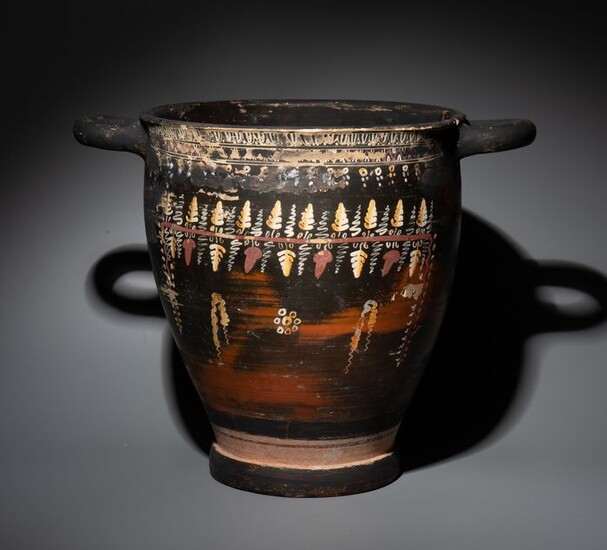Ancient Greek Pottery Gnathia Skyphos vessel vase. 24 cm H. Very Big
Skyphos form vase with white decoration CULTURE: Greek, Gnathia PERIOD: 4th Century BC MATERIAL: Pottery DIMENSIONS: Height 24 cm PROVENANCE: Private collection from SVV Declerck, BRUSSELS. Ancient belgian collection, 1970 - 1980. CONDITION: Restored from fragments, some re-painting on the black areas. DESCRIPTION: A beautifully decorated pottery vase from the region of Apulia which, given its form, can be identified as a bell skyphos. This example is painted entirely in a satin black colour apart from the two bands of clay-red colour which circle and embellish the foot. The high quality of the black glaze finish acquired after the firing is a perfect support for the decorative patterns painted on the belly of the vase in white, brown and golden yellow. Below the rim at the level of the handles, it is decorated with elaborate bands, one of ovalo, a fillet, a row of dots and one of bunches of grapes and tendrils. The main decoration on the body of the vase is made up of a garland of grapes and vine leaves which frame the image of a box painted in white along with two vegetal elements. These motifs are closely associated with Dionysus, the Greek god of wine, and it is therefore not surprising that they are to found decorating a vessel to be used to hold, mix and serve wine during a symposium. The reverse side is totally plain, without any decoration at all. This is a typical piece of ceramic ware that can easily be related to the so-called “Gnathian” production, and more precisely to the ancient town of Egnazia, on the coast of modern day Puglia (the designation is inappropriate and dates to the 19th century) . Such vessels were produced in southern Italy for some one hundred years, from the mid-fourth century BC until late in the following century. With their glossy black glaze, and the frequent presence of gadroons, they tend to imitate metal ware. The decorative patterns (figural, vegetal and most often geometric) were applied to the black painted surface and highlighted in white, brownish/gold yellow and, more rarely, purple – as beautifully exemplified here. Notes: The seller guarantees that he acquired this piece according to all national and international laws related to the ownership of cultural property. Provenance statement seen by Catawiki. The piece includes authenticity certificate. The piece includes Spanish Export License (Passport for European Union) - If the piece is destined outside the European Union a substitution of the export permit should be requested. This process could take between 1 and 2 months.
[ translate ]View it on
Estimate
Time, Location
Auction House
Skyphos form vase with white decoration CULTURE: Greek, Gnathia PERIOD: 4th Century BC MATERIAL: Pottery DIMENSIONS: Height 24 cm PROVENANCE: Private collection from SVV Declerck, BRUSSELS. Ancient belgian collection, 1970 - 1980. CONDITION: Restored from fragments, some re-painting on the black areas. DESCRIPTION: A beautifully decorated pottery vase from the region of Apulia which, given its form, can be identified as a bell skyphos. This example is painted entirely in a satin black colour apart from the two bands of clay-red colour which circle and embellish the foot. The high quality of the black glaze finish acquired after the firing is a perfect support for the decorative patterns painted on the belly of the vase in white, brown and golden yellow. Below the rim at the level of the handles, it is decorated with elaborate bands, one of ovalo, a fillet, a row of dots and one of bunches of grapes and tendrils. The main decoration on the body of the vase is made up of a garland of grapes and vine leaves which frame the image of a box painted in white along with two vegetal elements. These motifs are closely associated with Dionysus, the Greek god of wine, and it is therefore not surprising that they are to found decorating a vessel to be used to hold, mix and serve wine during a symposium. The reverse side is totally plain, without any decoration at all. This is a typical piece of ceramic ware that can easily be related to the so-called “Gnathian” production, and more precisely to the ancient town of Egnazia, on the coast of modern day Puglia (the designation is inappropriate and dates to the 19th century) . Such vessels were produced in southern Italy for some one hundred years, from the mid-fourth century BC until late in the following century. With their glossy black glaze, and the frequent presence of gadroons, they tend to imitate metal ware. The decorative patterns (figural, vegetal and most often geometric) were applied to the black painted surface and highlighted in white, brownish/gold yellow and, more rarely, purple – as beautifully exemplified here. Notes: The seller guarantees that he acquired this piece according to all national and international laws related to the ownership of cultural property. Provenance statement seen by Catawiki. The piece includes authenticity certificate. The piece includes Spanish Export License (Passport for European Union) - If the piece is destined outside the European Union a substitution of the export permit should be requested. This process could take between 1 and 2 months.
[ translate ]


